Guide to soil moisture sensors: Why use them and the options
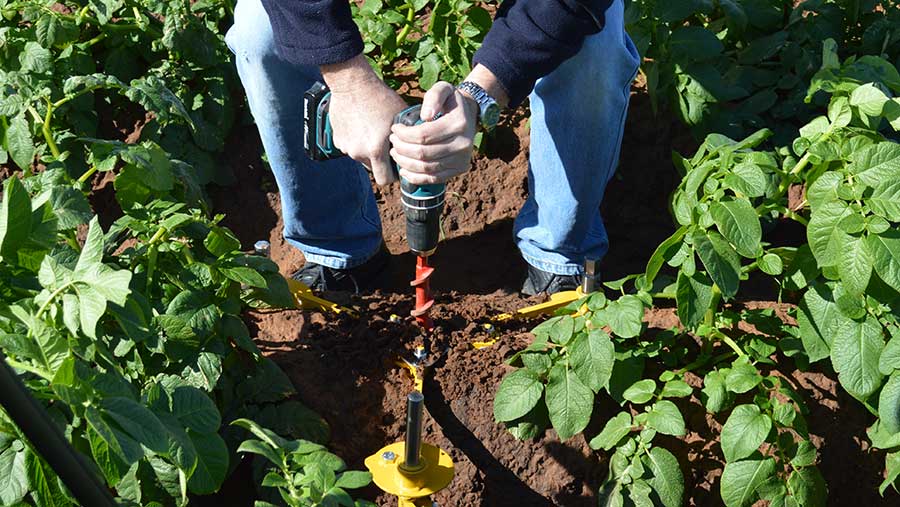
There are many good reasons for growers to use some form of soil moisture-sensing technology to monitor conditions and how the water is being used in irrigated crops.
First and foremost, it can make good business sense, as irrigation can be fine-tuned and result in savings or improvements in crop yield or quality that can soon claw back the investment in sensor systems.
In addition, with climate change and tighter regulation of water abstraction putting pressure on supplies for agriculture, using water resources more wisely and having a record of doing so is becoming much more important. Sensors can tick these two boxes.
See also: Low-input cropping plan slashes costs and risk for tenant farmer
Sensor types
Essentially, there are two types of soil moisture sensor, water potential sensors such as tensiometers, and granular matrix sensors, and those that give a percentage or relative water content of soil.
A tensiometer measures suction pressure at its porous tip, replicating how hard a root has to work to extract water from the soil.
These sensors are high-maintenance and only work well in situations where soils stay relatively moist. They also display readings in kilopascals (kPa), which is more difficult to directly relate to water use.
Granular matrix sensors pass a current across a porous media such as gypsum, with electric resistance changing proportionally to the amount of water drawn in and out. They are cheap and low-maintenance, but accuracy can be variable.
The drawbacks have largely seen irrigators move away from both these types of water potential sensors and towards capacitance sensors or time and frequency domain sensors.
Capacitance sensors
Capacitance sensors typically measure soil moisture at several depths and at 10cm or 20cm intervals, tracking how water is moving through the soil profile and the relative soil moisture at each interval.
As they only measure a small volume of soil near the access tube or the wall of the sensor, readings aren’t entirely representative.
The kit can also be affected by salts in the soil – they tend to increase electrical conductivity and cause the sensor to overestimate the water content of the soil.
Installation is critical, as soil contact with the sensor needs to be maximised and soil structure disturbance around the sensor minimised to ensure the readings are accurate.
Time domain reflectometry (TDR) sensors are very accurate and typically consist of two or three metal prongs between 5cm and 30cm long. These are installed by digging a hole and pushing the prongs into the undisturbed soil.
Soil moisture is measured 3-6cm around the sensor, so they can monitor larger volumes of soil and, when installed correctly, offer more representative results than other types of sensors.
There are three main players in soil moisture sensing, either selling direct to growers or through selected dealers. These include Australian firm Sentek, US-based Meter and British maker Delta-T, although others are available.
Sentek
While Sentek offers a range of products for soil moisture monitoring, the one of interest to UK potato and veg growers is its Drill and Drop capacitance sensor, which can work at depths between 30cm and 120cm.
However, as the majority of roots in crops such as potatoes rarely reach more than half the probe’s maximum depth, a common set-up in the UK would operate at 60cm.
Along those 60cm, six sensors at 10cm spacings take moisture readings every 30 minutes and send a soil moisture content reading in millimetres (mm) and soil temperature reading to a data logger at the soil surface.
The logger then uses a GPRS signal to send the data to a cloud-based system, which can be accessed by farm or irrigation managers on the ground via a computer, tablet or smartphone.
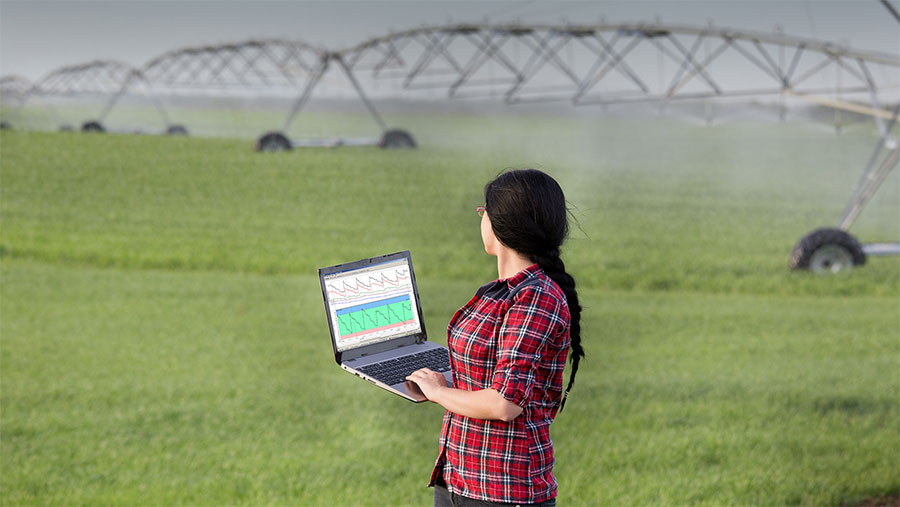
Most Drill and Drop installations have an electronic rain gauge positioned on top to account for precipitation and applied irrigation and their effect on soil moisture content.
There is also the option of Sentek’s Triscan sensor, which offers all the same features as the Drill and Drop, as well as additional data on soil salinity. This can be used to track nutrient leaching and crop use through the soil profile.
The Drill and Drop probe installation method is unique and should provide accurate results.
Instead of digging a pit to insert sensors into the profile or using a “slurry mix” to backfill around the probe, a tapered auger drills a hole in the ground.
The probe is then gently pushed in and because the soil structure around the instrument isn’t significantly disturbed, it provides representative and repeatable results. The ease of installation and removal also makes it ideal for annual crops.
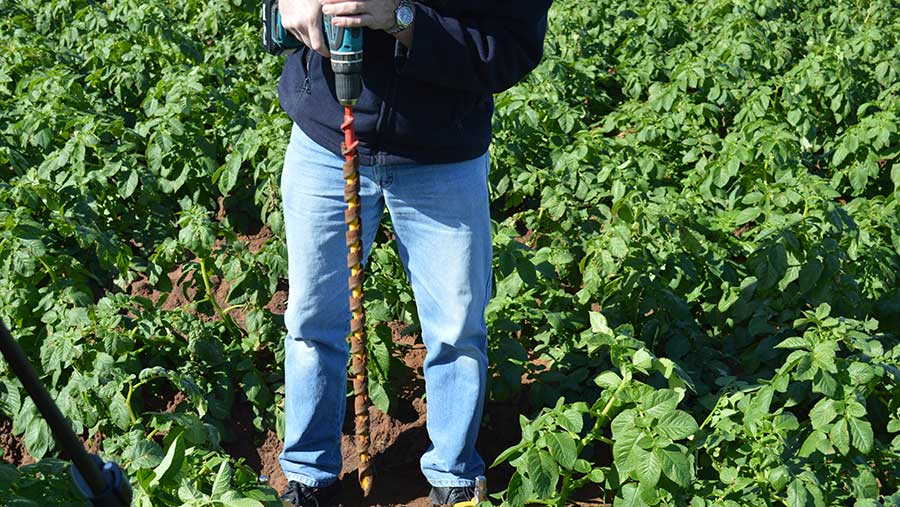
Most existing users in the UK will buy or hire the equipment from a service provider such as Suffolk-based Soil Moisture Sense, with the company also taking care of installation, service and data handling.
A single Drill and Drop with electronic rain gauge costs £975 to buy, with a £65 installation fee. Users then pay £275/year for the support service, which includes data handling, two soil moisture content graphs a week and an-end-of-season report.
The annual subscription can be reduced where multiple sensors are installed. Hiring costs are £635/season, inclusive of all costs.
Meter
US company Meter – formally known as Decagon – is another well-established brand in the soil moisture sensor market and Hampshire-based specialist Labcell sells, supplies and supports its range across the UK.
Its core offering is the Teros range, which uses high-frequency capacitance technology to measure soil moisture, temperature and conductivity.
The sensors – which consist of three sharpened stainless-steel prongs that output the gadget’s charge into the soil – have a low power requirement and give either analogue (Teros 10) or digital (Teros 11 and 12) signal to a datalogger and/or handheld device.
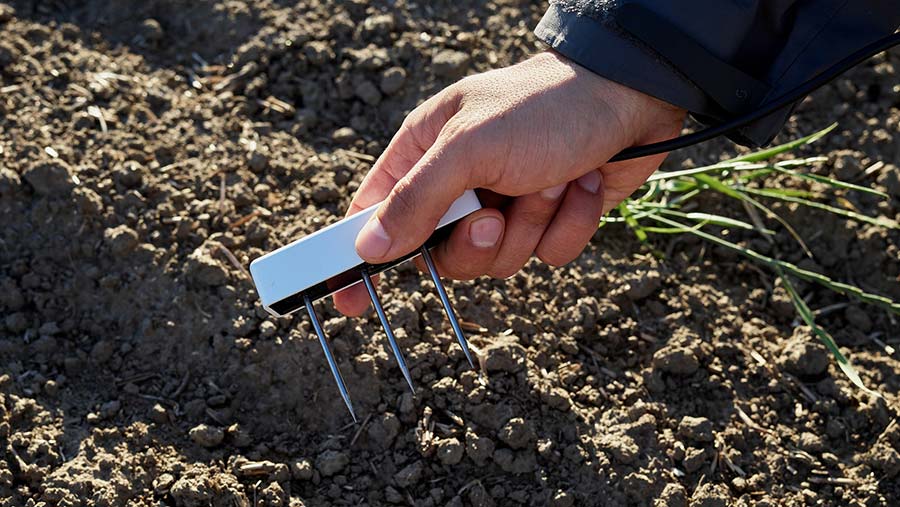
Teros 12
Cable length is typically 5m, allowing the sensors to be placed at a number of depths through the soil profile. Cables can also be extended to, say, 40m, where a grower or researcher wants to monitor soil moisture over a much wider area.
The sensors are compatible with a number of dataloggers, but Meter recommends its ZL-6 box, which can take inputs from up to six sensors in the field and transmit data straight to a cloud-based platform.
Information is stored on the logger and uploaded hourly to the cloud via a mobile signal. A yearly subscription to Zentra allows users to access, download and analyse it in detail.

The ZL-6 box
Labcell sell and support the hardware, including sensors, cabling, diagnostic/installation checkers and dataloggers, but don’t offer hire of sensors.
The biggest difference is in the installation of the Teros-type sensors. Rather than being drilled into the ground, a larger hole is dug, sensors placed at the desired depths through the profile and then backfilled once the cables are connected to a datalogger.
This lends their use to more permanent installations, rather than in annual crops, but they can still be used in these situations if placed in areas representative of the crop and soil type.
Sensors for Teros 10, 11 and 12 cost £100-£200, depending on the quantity purchased and cable length. A six-channel, GPS-enabled ZL6 data logger, compatible with a smart device app, is £560, and an annual data subscription using the Zentra cloud platform is £160.
This sees a system comprising six sensors, datalogger and first year subscription costing about £1,900.
Delta-T
Cambridge-based Delta-T’s range of soil moisture sensors are well established in research and horticultural sectors.
It has a number of sensors suitable for spot moisture readings when growing crops in substrates, such as strawberries, but for broadacre farmers looking for season-long monitoring of soil moisture, its PR2 Profile Probe is a good option.
The PR2 is dual purpose, so it can either be permanently installed to log soil moisture over time, or it can be portable, with the farm or irrigation manager dropping the probe into access tubes buried in the ground and taking a spot reading when required.
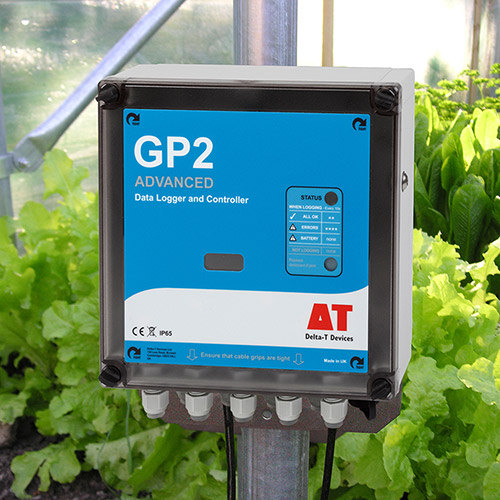
Delta T soil probe
The PR2 is available in two sizes measuring to a depth of either 40cm or 100cm. The PR2/4 has four sensors at 10cm intervals, while the PR/6 has two additional sensors at 60cm and 100cm.
When installed, up to three PR2/4s and two PR2/6s can be hooked up to Delta-T’s GP2 datalogger, which stores the soil moisture data readings. The data can then be downloaded to a laptop or, with the addition of a GPRS modem, wirelessly sent back to the farm office.
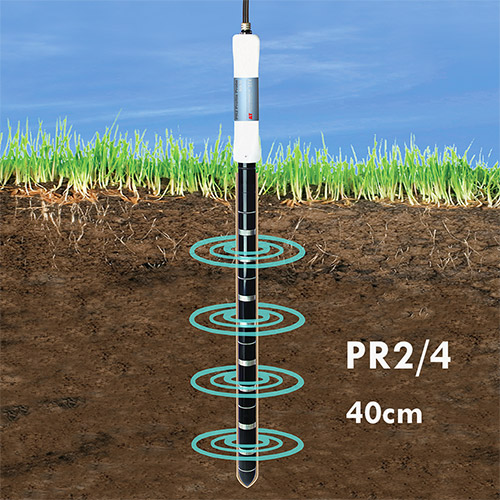
Delta T PR2/4
The company offers a free data gathering and file sharing service to complement the hardware, or there is the option to use compatible third-party software or cloud-based systems to manage and interpret the probe’s output.
For the portable option, a HH2 handheld meter can be used along with the probe to record soil moisture. Information is transferred to a computer via USB, providing a fast and efficient way to get data covering a large area.
The price of the Delta-T PR2 probe depends on which options customers choose, the situation and resource, but an approximate cost for a probe, datalogger and modem with battery and data package is £2,600, including a two-year warranty.
Delta-T stresses there is no annual fee for the cloud site and the data package can last up to three years, depending on customer setup.
Other factors include the frequency and amount of data they wish to download and whether certain options are bolted on, such as the ability to remotely change programmes.
For installation of the PR2, users will have to purchase an installation kit, which includes augers for drilling holes.
Some of the information presented in this article was provided by irrigation expert Rohan Prince of the department of agriculture and food in Western Australia.

